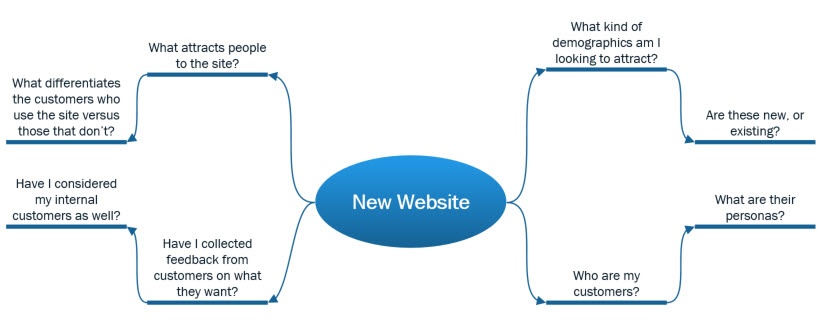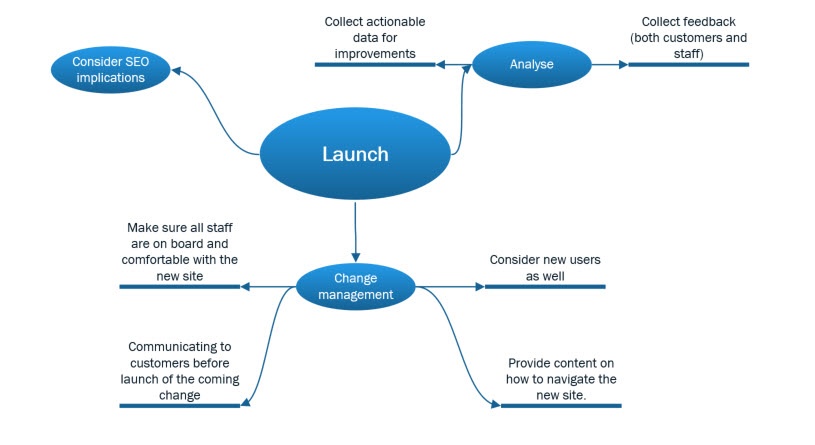The prospect of a new website is exciting to most people who operate in the digital space – or maybe that’s just me. There are so many opportunities to improve and innovate. But getting the launch process right can be hard. We’ve seen it numerous times, after all, it’s what we do. So I thought I’d share some of the key points we’ve found that are important for you to consider when you’re launching a new site.
To quote a very quotable man; “The secret to getting ahead is getting started”. So, let’s start at the beginning.
You’re thinking about a new website. What does that look like? Maybe something like this:

Don’t be afraid to engage Subject Matter Experts (or SMEs) – either internal or external – at this stage (in fact, we’d encourage it). You want people who live and breathe what they do as they’re going to know any intricacies and details you might not have considered.
There’s a few key points here you will probably want to look at:
The first, and deceptively simple, question to ask is: “who are my customers?”. Now the easy answer to this is something along the lines of “people who buy from me” but let’s think a little bit more strategically. What do these people like? How do they shop? Do they care more about convenience or price? Are you better off with a focus on new products/lines or a focus on your core range? Are you looking only on your existing customer bases or do you want to attract new potential markets as well?
Next is along the same lines and is normally partially answered while you’re working on the first point. What attracts people to your site? This can be your current site (if you have one), your new site, or both! Are people driven primarily by accounting functionality like paying invoices, or is it a purchasing platform, or used as an online catalogue, or a combination of all? Once you understand the primary motivations of your customers (both new and existing) you can make sure that your new site makes the things they want to do intuitive and simple.
One of the other points that I personally feel is exceptionally important is feedback from your customers. Remember that your customers are not just the people you issue invoices to. They are also your sales reps, your customer service staff, anyone within the business that has a day to day connection to the website. They are your best resource for pain points on the current site, user feedback, and new suggestions so make sure you’re listening to what they have to say.
And then…
Once you’ve moved from thinking to doing the process doesn’t slow down. It’s important to consider the key elements of the website and their ease of use. Often times it will be a balancing game between different elements. There’s no One Right Way on this. It’s a question of what suits your customers, your products, and your web offering. So long as you keep the key functions of the site in mind at all time, and consider the input of the SMEs - and are prepared to analyse the results - you’re on the right track.
Thunderbirds are go!
Before you know it you’re ready for the site to go live. Since a picture says a thousand words, let’s go back to the trusty mind map to take a look at some of the things that are important to consider:

If we’ve spoken you’ve probably heard me talk about change management. I’m very much a believer that it is integral to a good website launch. As much as we love a good thing (because really, who doesn’t?) change is still scary. It may be good in the long run but if I don’t understand it I’m going to get frustrated. And frustrated customers are not happy customers.
So, before you launch it’s a good idea to make sure that all your customers are comfortable with what the new website is going to bring to the table. Let staff know what it’s going to look like, what the key functions are and how they work. Consider doing up an explanation video or guide for your customers so they feel supported through the change.
While it would be great to get everything absolutely right the first time, it’s incredibly unlikely. People change their mind, what they think they need is not necessarily what they actually need, there may be new things they hadn’t considered until they’re faced with the reality of the site. Be prepared for this feedback and use it to your advantage. Have an easy way to consolidate it so any future changes to the site can be data driven rather than anecdotal.
As with any major website change, make sure you consider any SEO implications. These could be large or small, but it’s always better to be proactive than reactive so have a plan ready to go before launch.
Then last but certainly not least:

